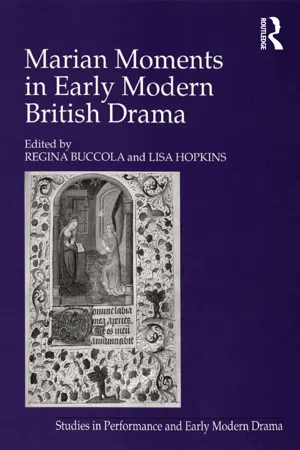
- 198 pages
- English
- ePUB (mobile friendly)
- Available on iOS & Android
Marian Moments in Early Modern British Drama
About This Book
Concerning itself with the complex interplay between iconoclasm against images of the Virgin Mary in post-Reformation England and stage representations that evoke various 'Marian moments' from the medieval, Catholic past, this collection answers the call for further investigation of the complex relationship between the fraught religio-political culture of the early modern period and the theater that it spawned. Joining historians in rejecting the received belief that Catholicism could be turned on and off like a water spigot in response to sixteenth-century religious reform, the early modern British theater scholars in this collection turn their attention to the vestiges of Catholic tradition and culture that leak out in stage imagery, plot devices, and characterization in ways that are not always clearly engaged in the business of Protestant panegyric or polemic. Among the questions they address are: What is the cultural function of dramatic Marian moments? Are Marian moments nostalgic for, or critical of, the 'Old Faith'? How do Marian moments negotiate the cultural trauma of iconoclasm and/or the Reformation in early modern England? Did these stage pictures of Mary provide subversive touchstones for the Old Faith of particular import to crypto-Catholic or recusant members of the audience?
Frequently asked questions
Information
Chapter 1 ‘Here in this garden': The Iconography of the Virgin Queen in Shakespeare's Richard II
The erle Marshall, beyinge on his knees, sayde to her: Fayre lady, by the grace of God ye shall be our lady and quene of Englande. Than aunswered the yonge lady well advysedly, without counsayle of any other persone: Syr, quod she, and it please God and my lorde my father that I shall be quene of Englande, I shall be glad therof, for it is shewed me that I shall be than a great lady. Than she toke up the erle Marshall by the hande, and ledde him to the quene her mother, who had great joy of the answere that she had made, and so were all other that herde it. The maner, countenaunce, and behavoure of this yonge lady, pleased greatly the ambassadours, and they sayd amonge themselfe, that she was lykely to be a lady of hygh honoure and great goodnesse. 44Froissart, 6.159.
Table of contents
- Cover
- Halftitle Page
- Editor Preface
- Title Page
- Copyright Page
- Contents
- Contributors
- Preface
- Foreword
- Introduction
- 1 ‘Here in this garden’: The Iconography of the Virgin Queen in Shakespeare’s Richard II
- 2 ‘One that’s dead is quick’: Virgin re-birth in All’s Well That Ends Well
- 3 Inverting the Pietà in Shakespeare’s King Lear
- 4 ‘Black but Beautiful’: Othello and the Cult of the Black Madonna
- 5 Desdemona and the Mariological Theology of the Will in Othello
- 6 The Wonder of Women: Virginity, Sexuality and Religio-Politics in Marston’s The Tragedy of Sophonisba
- 7 Easter Scenes from an Unholy Tomb: Christian Parody in The Widow’s Tears
- 8 Virgin Fairies and Imperial Whores: The Unstable Ground of Religious Iconography in Thomas Dekker’s The Whore of Babylon
- 9 Not kissing the (He)rod: Marian Moments in The Tragedy of Mariam
- Index